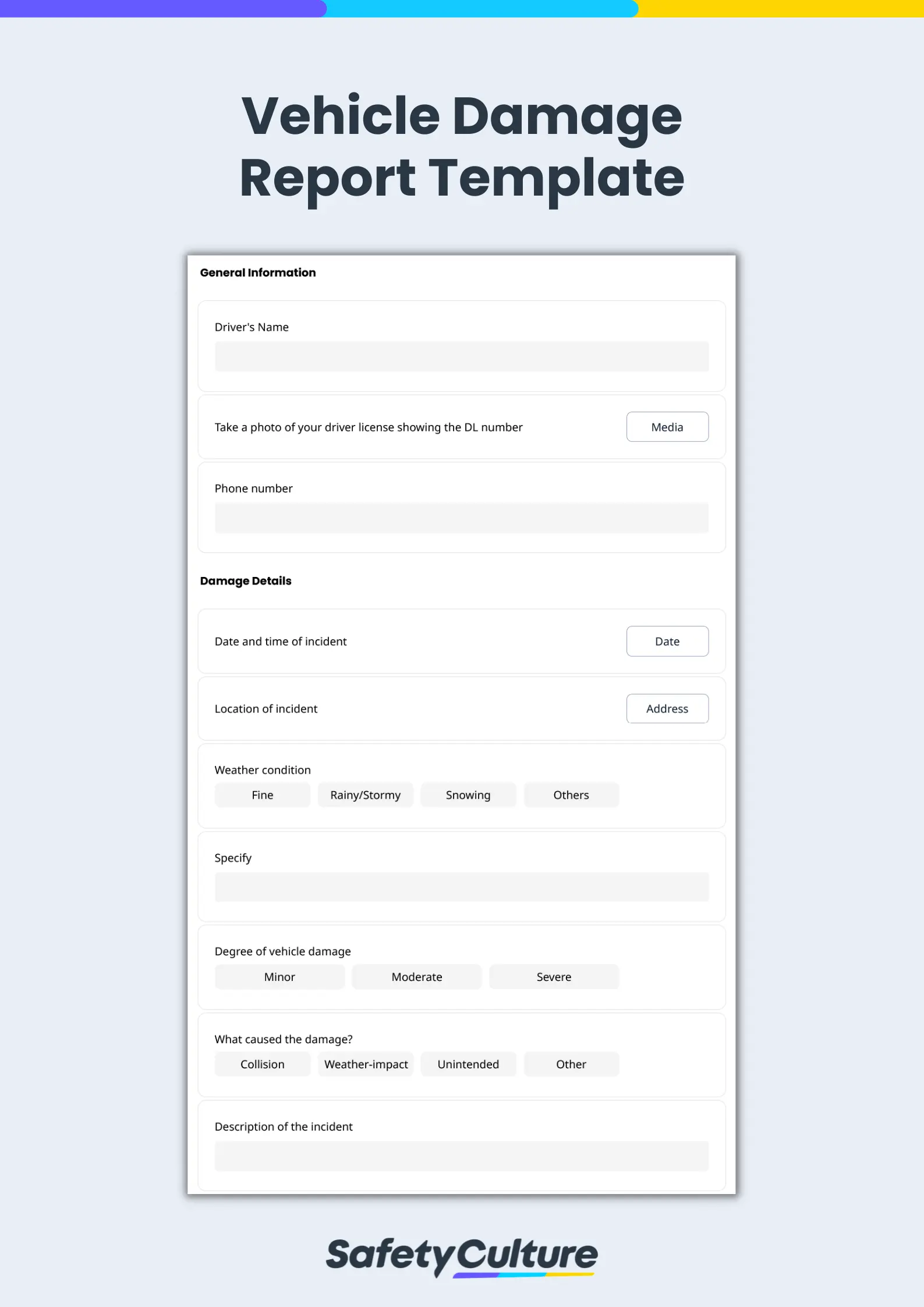What is a Vehicle Damage Report?
A vehicle damage report summarizes the overall findings from a vehicle damage assessment. Damage reports are used by drivers and fleet managers to support insurance claims. The report documents information regarding vehicles and parties involved, details of the accident, and the extent of the damage.
Why is it Important?
A vehicle damage report is an essential document for various reasons. For one, it allows fleet managers to calculate and evaluate the necessary repairs and replacements for the damaged vehicle. This report can also protect drivers and fleet personnel in case of accidents. By giving a detailed account of the cause and extent of the damage to your vehicle, you can ensure that you are not held liable for any harm you did not cause.
In addition, a vehicle damage report also serves as an official record of the accident. It can be used not only as court evidence but also as supporting documentation to justify compensation claims from insurance providers or other responsible parties.
It’s best to file this report at the earliest time possible, even if no significant injuries or damage are sustained. If not filed promptly, companies may have issues qualifying for the benefits or receiving them in full.
How Do You Assess Car Damage?
Before you begin to assess car damage for insurance purposes, you must take care of any pressing medical concerns first and call for medical attention if needed. Once the health and safety concerns are covered, and there is no risk of sustaining further injuries, you can proceed with assessing the car damage and do the following:
- Inform the legal authorities, such as the local police, so you have a legal record of the vehicular accident.
- If the vehicle is a company asset, submit an incident report that includes details surrounding the event, any injuries sustained, and other people involved.
- Take photos of any damage to your car and other vehicles that may have been involved in the incident. Photos may include external as well as internal damages to the car.
- Make some notes and be as detailed as possible about what happened. The information will be vital for insurance companies and legal authorities when assessing your claims.
- Contact your insurance provider to inform them about the car damage and discuss if there is a need for certain urgent repairs in order to prevent further damage to the vehicle. Discussing the car damage with the insurance provider will also give you a better understanding of what to do next and be aware of any costs to fix the damage.
Elements of a Good Vehicle Damage Report
A good vehicle damage report heavily relies on the proper performance of the damage assessment. Vehicle damage assessments should be able to capture not only general information about the time, location, vehicle, and parties involved but also focus on factual details of the accident and the extent of the damage.
Below are two key elements that an effective vehicle damage report should contain:
Details of the Accident
Should cover all the circumstances and possible contributing factors which caused the accident. Details should be as factual and impartial as possible with opinions supported by evidence or explicitly made clear. Opinions of who caused the accident should be supported with sketches, witness statements, and photo evidence.
Extent of Damage
Vehicle damage primarily arises as a result of a collision, weather impact, and unintended scratches or dents. It is important to identify all areas of the vehicle that have been damaged and capture sufficient photo evidence of the key damaged areas. It is also important to take photos of the surrounding vehicle and/or environment involved in the damage.
A good vehicle damage report underpinned by facts, photo evidence, and witness statements will offer better support for insurance claims and good fleet recordkeeping.
How to Write a Vehicle Damage Report
Creating a vehicle damage report can seem overwhelming, especially if you’re doing it for the first time. But with the right information, you can write a comprehensive report that accurately captures all essential incident details and the extent of damage to your vehicle.
Here are the steps to follow when writing a vehicle damage report:
- Begin by filling out the information about your vehicle. Specify its registration number, identification number, year, make, and model.
- Next, get the basic facts about the incident. Note the date and time, location, and contact information of the driver involved in the incident.
- Then, describe the damage in detail. Indicate the weather condition, degree of damage, potential cause, and a clear explanation of the incident.
- Back up your description by recording the extent of damage to the vehicle. Capture photos of the damaged vehicle and its surroundings from various angles, including close-up and wide shots.
- Mention the names, contact details, and vehicle information of the other parties involved, if any. Briefly state the extent of vehicle damage incurred and include photos as proof.
- Supply other information that may be relevant to the case, including the names of the witnesses and observations that aren’t included in the incident descriptions.
- Complete the report with signatures from the driver and fleet manager.
Common Mistakes to Avoid When Filing a Report
When creating a vehicle damage report, drivers and fleet managers must be mindful of errors that could lead to inaccuracies or misinformation. To avoid them, here are 4 common mistakes to watch out for when filing this report:
- Failing to document all damage – It’s essential to report all damages to the vehicle, no matter how minor they may seem. Even the smallest scratches or dents can significantly impact the vehicle if unresolved.
- Supplying inaccurate information – Erroneous or mismatched data could compromise the validity and reliability of the damage report. Thus, it’s a must to review the incident and damage details in the report to verify that it’s accurate and detailed.
- Waiting too long to submit the report – Vital information and evidence could get easily lost if companies take too long to file a damage report. The best way to prevent this is by filing the report as soon as possible after the incident.
- Failing to sign off the report – Lastly, affix the signatures of the persons responsible to make the report official and valid. Digital vehicle damage report templates allow users to electronically sign the form and automatically have it date- and time-stamped.
FAQs About Vehicle Damage Reports
The most common approach to discovering damage inflicted on a car is through a detailed car inspection or by preparing a vehicle damage report. Through these inspections, owners and insurance companies can easily check the car’s parts and take note of any physical, mechanical, or electrical issues observed.
When describing the damage, take note of the location, type of damage, size, severity, and any other relevant information about the issue observed. Attaching a photo of the specific area will also increase the credibility of the report, as it provides a visual aid needed for assessment.
Drivers, fleet managers, insurance adjusters, collision repair technicians, and law enforcement officers or investigators are just some of the individuals who can leverage the use of vehicle damage reports. However, anyone who needs to document the damage to a vehicle for any reason can prepare this report as long as they have sufficient knowledge and expertise to accurately assess the damage.




